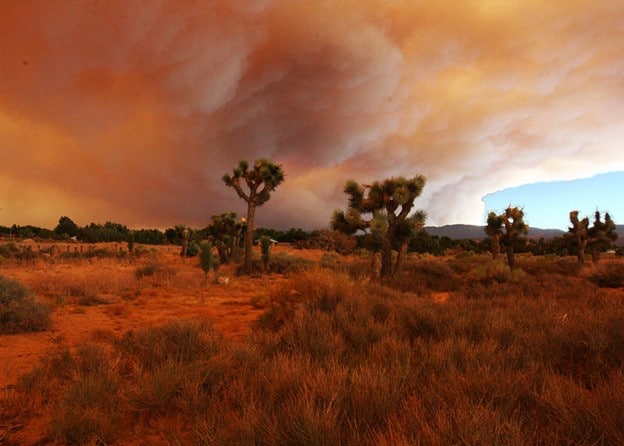As the frequency and size of wildfires continue to increase, research by Carnegie Mellon University scientists found that the chemical aging of particles emitted by fires can lead to more extensive cloud formation and intense storm development.
The researchers said that introducing large amounts of ice-nucleating particles due to fires can cause “substantial impacts “on cloud microphysics.
(Read “Storm season has the solar industry looking to protect assets from costly hail damage.”)
The scientists collected plant materials, burned them, and analyzed the particles emitted in the smoke. They focused on ice-nucleating particles that can catalyze ice crystal formation at higher-than-usual temperatures and affect cloud formation.
With a specialized chamber reactor, mass spectrometers, electron microscopy, and a microfluidic droplet freezing technique, the researchers analyzed the particles. They also simulated the aging that these particles would undergo in the atmosphere. Their work found that chemical aging of particles emitted by wildfires can lead to more extensive cloud formation.
The U.S. National Science Foundation-funded research was published in Science Advances.
Coal was down but not out
Last year marked the first time that coal was not the largest–or even the second-largest–source of annual electricity generation in the United States since at least 1949.
U.S. coal-fired electricity generation totaled 774 million MWh in 2020. That was less than both natural gas-fired (1.6 billion MWh) and nuclear-powered generation (790 million MWh), according to the U.S. Energy Information Administration (EIA).
However, EIA said it expects coal-fired generation to increase and for nuclear-powered electricity generation to decrease in both 2021 and 2022.
Coal-fired capacity was 313 GW in 2008 and its capacity factor was 72%. Capacity factors measure the output for a fleet of generators as a percentage of what those generators are capable of producing. In 2020, coal’s operating capacity was 223 GW, and the fleet’s capacity factor was 40%. U.S. nuclear power had 97 GW of capacity in 2020, and a capacity factor of 93%.
EIA said expects coal-fired generation to grow and for nuclear-powered generation to fall both this year and next. Higher prices for natural gas will make coal more competitive. This expected increase in coal’s use more than offsets the upcoming retirement of 2.8 GW of coal capacity in 2021 and another 8.5 GW in 2022, EIA said.
EIA also said it expects nuclear-powered generation to drop as three nuclear plants (totaling 5.1 GW of capacity) retire this year. One nuclear power plant, Vogtle, in Georgia, plans to add 1.1 GW of capacity in November 2021 and 1.1 GW in November 2022.
Solar for airports enters service
Ameresco said it achieved commercial operation at its 4.95 MW solar energy site in Tiverton, and mechanical completion at its 5.71 MW site in Cumberland, both in Rhode Island.
The Rhode Island Airport Corp. entered into a long-term agreement as the designated off-taker of energy generated from both sites. The airport is expected to net an annual cost savings of around $790,000 once the two projects are in service.
Commercial operation of the Cumberland project is expected by April.
Landfill gas flows for SoCalGas
Southern California Gas Co. said that natural gas diverted landfill waste is now flowing into its pipeline system from Anaergia Inc.’s Rialto Bioenergy Facility, around 50 miles east of Los Angeles.
A mile-long pipeline connects the facility to an existing SoCalGas pipeline. This is the fifth project in which landfill gas has been injected directly into SoCalGas’ system.
The facility uses anaerobic digestion technology and processes up to 300,000 tons of waste diverted from local landfills. SoCalGas said it is now distributing natural gas from nearly 25 dairy farms and more than 18 cities’ refuse collectors.
Earlier this month, Australian energy storage company Redflow Ltd said it will supply a 2 MWh energy storage system made up of 192 zinc-bromine flow batteries to the Rialto facility.
The microgrid was funded in part by a grant from the California Energy Commission and consists of batteries, a biogas conditioning system, and a control system.
This content is protected by copyright and may not be reused. If you want to cooperate with us and would like to reuse some of our content, please contact: editors@pv-magazine.com.









By submitting this form you agree to pv magazine using your data for the purposes of publishing your comment.
Your personal data will only be disclosed or otherwise transmitted to third parties for the purposes of spam filtering or if this is necessary for technical maintenance of the website. Any other transfer to third parties will not take place unless this is justified on the basis of applicable data protection regulations or if pv magazine is legally obliged to do so.
You may revoke this consent at any time with effect for the future, in which case your personal data will be deleted immediately. Otherwise, your data will be deleted if pv magazine has processed your request or the purpose of data storage is fulfilled.
Further information on data privacy can be found in our Data Protection Policy.